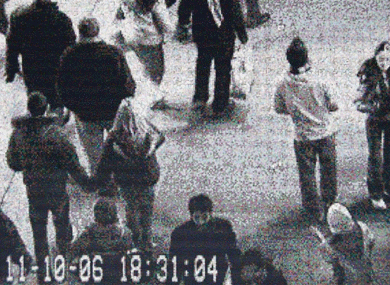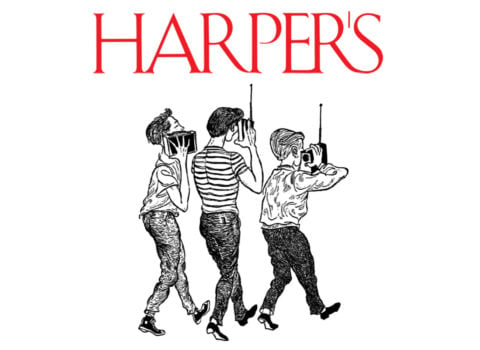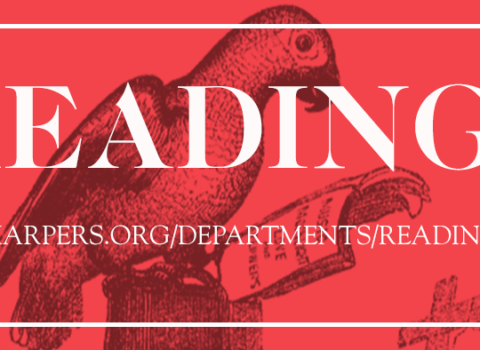“Cyberspace” is where old footage — and old ignorant prejudice — lives forever. The term made its fictional debut in a monologue by the disgraced hacker hero of William Gibson’s Neuromancer, published three decades ago this past summer:
Cyberspace. A consensual hallucination . . . A graphic representation of data abstracted from the banks of every computer in the human system. Unthinkable complexity. Lines of light ranged in the nonspace of the mind, clusters and constellations of data. Like city lights, receding . . .
Neuromancer was the debut volume of a trilogy called the Sprawl (1984–1988), the name of a teeming city situated between and subsuming former Atlanta and former Boston. Gibson’s subsequent trilogy was called the Bridge (1993–1999), the name of the shantytown erected atop the postapocalyptic cremains of the San Francisco–Oakland Bay Bridge. Across all six novels, “cyberspace” was deployed as narrative mode, plot device, setting, and metaphor and was used to predict the crucial subjects of today’s non-fiction: hacking, surveillance, terror, total mediation as false consciousness. But then, in the course of a single Tuesday morning in September 2001, the author’s near futures became our own near pasts. Gibson’s response was to take his greatest risk to date: his third trilogy — the Blue Ant trilogy, consisting of Pattern Recognition, Spook Country, and Zero History — would be a literary occupation of the present. Its initial installment was published in February 2003, just before America invaded Iraq seeking virtual WMDs.
In Pattern Recognition, Cayce Pollard, a New York–based “coolhunter” and corporate-branding semiotician for the viral advertising company Blue Ant, watches the 9/11 attacks from Canal Street: “It will be like watching one of her own dreams on television,” Gibson writes. “Some vast and deeply personal insult to any ordinary notion of interiority.” Cayce spends the next year on a search for “the footage”: a series of clips documenting either a real event or a performance-art project. It becomes impossible for Cayce, and so for the reader, not to imagine the clips in the searing light of looped CNN: the jets making impact, the towers collapsing, the handheld-camera shakiness that to some constitutes incontrovertible truth and, to crazier others, endlessly analyzable frames that fuel conspiranoia. On YouTube, it’s difficult to find images of what happened downtown that aren’t accompanied by commentary: Rumsfeld or Cheney ordered the controlled demolition of Tower 7; NORAD was ordered to stand down to allow the jets to enter New York airspace unimpeded; the Mossad warned Jews not to show up to work that day; the day before, insider traders dumped an inordinate amount of American Airlines stock.
Chat rooms concerned with all topics sci-fi have spent the past four years maniacally speculating about the next Gibson novel, and, as always, they were equally right (this one’s not about the present), and wrong (it is). The Peripheral (Putnam, $27.95), Gibson’s tenth novel, returns us to the future, or to two futures. And the WTC shadows them both.
Burton Fisher is a decorated veteran of a U.S. Marine division who now lives a dumpy rural existence in a Georgia riven by drugs. A mysterious outfit called Milagros Coldiron SA hires him to beta test a game: all he has to do is sit at the monitor of his trailer-park camper and fly a quadcopter around the fifty-fifth through fifty-seventh floors of a simulated tower in a simulated London to keep that swath clear of “bugs,” or paparazzi drones. But Burton decides to skip a session to attend a fellow soldier’s funeral, and so he subcontracts the job to his sister, Flynne, a gamer whose nom de jeu is Easy Ice. Flynne, glad to have the extra cash, logs on to the interface only to witness one of the bugs going rogue, breaking into a condo and killing a woman, scattering her bits to the air:
[Flynne] was never able to remember any more blood, just the tumbling form in its black t-shirt and striped pants, less a body every inch it fell, so that by the time they passed the thirty-seventh, where she’d first noticed the thing, there were only two fluttering rags, one striped, one black.
She pulled up before the twentieth, remembering the voices. Hung there in the gyros’ slack, full of sorrow and disgust.
“Just a game,” she said, in the trailer’s hot dark, her cheeks slick with tears.

11–10–06 18:31:04, by William Betts. Courtesy the artist and Margaret Thatcher Projects, New York City; Collection of AT&T
But it’s not, of course. It soon becomes evident that Burton and Flynne exist some seventy years earlier than the time of their employer — on the doomed side of what Gibson calls “the jackpot,” an ecological catastrophe that occurred roughly coevally with the appearance of “the server” in China. “The server” is a scantily understood technology that allows the future to communicate with the past, “or rather a past. . . . The act of connection produces a fork in causality, the new branch causally unique. A stub, as we call them.” That’s the explanation of Lev Zubov, a Russian oligarch in London and a “continua enthusiast” who’d exploited Flynne and Burton’s “stub,” using the siblings as bodyguards for the dead woman and her sister. The ensuing homicide investigation requires Flynne to project into Future #2 — not as her own flesh self but as a “peripheral,” a robotic double that she controls remotely back in Future #1.
A whole lot else happens too, involving, in Future #2, the Sherlockian/steampunk-Dickensian adventures of a detective named Lowbeer. Future #1, meanwhile, takes us to a gritty Dixie whose sole economies are “fabbing” (counterfeiting equipment) and “building” (synthesizing amphetamines). The signal achievement of Gibson’s brilliant novel lies not in its surfeit of invention, however, but in the seriousness of its concerns: how it takes historical revisionism literally and dramatizes its effects. In The Peripheral, as in our own world, the past is a serious plaything, too often used to justify murder.
Fiction is one of two ways we currently have of traveling through time. The other is to travel from South to North Korea: from Samsung-sponsored clamor to a dictatorship of barbed-wired penal camps with nary a bar of WiFi. It’s nearly as difficult for an American to obtain a visa to the DPRK as it is to obtain copies of the hundred books its government has approved for reading. The novel used to be the DPRK’s official literary art, until a 1994 paper shortage motivated the Choson Writers’ Alliance, the state council in charge of publishing (read: censorship), to retract that honor and accord it to poetry instead.
For the past two years, Illinois-based Dalkey Archive Press has been engaged in a troubling but ultimately vitalizing project. Noting the financial pressures that prevent American presses from exploring literature in translation, they’ve initiated the dubiously denominated National Literature Series, schemes in which a “partner country” underwrites the English-language versions of native works. Dalkey’s Library of Korean Literature will consist of twenty-five volumes of fiction chosen in consultation with the Literature Translation Institute of Korea (even the names of the library and institute are charged: the epithets “Korea” and “Korean,” if used alone, always refer to South Korea, and all twenty-five volumes are by South Korean writers). They range from socialist-realist epics to the type of cutting-edge babble better scrolled through on phones. The diversity of styles, periods, and the ages and genders of the authors provides an instructive blueprint for how regimes can seem democratic even while stifling dissent: Yi Kwang-su’s The Soil (1932–33) was chosen but lacks any editorial apparatus noting the author’s collaborationism with the Japanese; Jang Jung-il’s genre pastiche When Adam Opens His Eyes (1990) was picked, but not his subsequent novel, Try Lying to Me, which a Korean court deemed pornographic.

“Photo-opportunity in Insa-dong, Seoul” and “Photographing Soldiers at the Kimilsungia–Kimjongilia Exhibition Hall, Pyongyang,” by Dieter Leistner, from Korea–Korea, published last year by Gestalten.
The library’s three newest titles all take on Korea’s division, either directly as theme or through formal analogy. Another Man’s City (translated by Bruce Fulton and Ju-Chan Fulton, $16.95, dalkeyarchive.com), published in Korean in 2011, was the last novel by Ch’oe In-Ho, who seems to have been Korea’s Haruki Murakami. A protagonist called K is conducted through increasingly absurdist reenactments of his marriage and youth by a sentient computer alternately referred to as the Invisible Hand (i.e., of the Market) and Big Brother. After a church scene that restages the one in Kafka’s The Trial, K forsakes religion for science and splits into K1 and K2 — the letter converted from a fusty allusion to a mathematical operator. On a visit to the brothel district, amid the aftershocks of an earthquake, the K clones get a chance to size each other up and address the pressing issues, such as: Who gets the wife? And, Is it still incest if K2 has sex with K1’s sister? Central European modernism was fixated on metamorphosis. South Korean postmodernism is, too — or on schizophrenia, in which personalities, like capitalist commodities, are endlessly replicated.
Park Min-gyu Park’s Pavane for a Dead Princess (translated by Amber Hyun Jung Kim, $15.95, dalkeyarchive.com), published in Korean in 2009, concerns another kind of cleavage: it takes on the beauty fetishes of Korean culture. The year is 1985, the nascence of Korea’s tech sector: “a year average people suddenly came into money.” The nameless narrator, a handsome wannabe novelist, is employed as a part-time parking attendant at a ritzy new mall in Seoul. There he falls for a stock girl who is, or has decided she is, “the world’s ugliest woman” — at least the ugliest among her female coworkers, all of whom are hoping to meet a wealthy male customer and marry him so that they can become mall customers, too. It’s not quite gratifying to discover that in Korean, as in English, the most misogynist books tend to make the most noise about being antimisogynist:
The more the girls coalesced, the bolder they became. I overheard them talking of their shopping escapades, of how they maxed out their entire paychecks and later, overdrew on their savings to buy new things.
The cloying voice in which the narrator recounts his ostensibly freakish relationship is critiqued by metafictional asides that Park calls the “writer’s cut” of the novel. This dichotomizing seems to be an acknowledgment of how literature is engaged in prettifying, too — how authors, agents, editors, and publicists snip and spray for mass appeal, primping prose for market.
The final division of this series is the most fraught, and also the most factual. In the aftermath of WWII, Japan was stripped of Korea, and the 38th parallel separated American and Soviet zones. Lee Myong-jun, the hero of Choi In-hun’s The Square (translated by Kim Seong-kon, $14.95, dalkeyarchive.com), finds himself stuck in a stultifying job as a bank clerk in the South. His father, however, has found success in the North, delivering anti-Western diatribes on Pyongyang radio. Inevitably the cops start dropping by and dropping insinuations that Myong-jun might be a communist himself, and their scrutiny compels his defection. He crosses the border into what he expects will be a Marxist-Leninist paradise of labor and is disabused again, by his father and Fatherland both. In 1950 the North attacks the South (beginning what America calls the Korean War, the South calls the Upheaval, and the North calls the Liberation), and Myong-jun is conscripted into the People’s Army, fights, and is taken prisoner in the battle of Nakdong. At the conclusion of hostilities in 1953, President Syngman Rhee releases the northern POWs, and in a moment of benevolent diplomacy or canny PR lets them decide which Korea to live in. Myong-jun can choose neither. He opts for “The Square,” which doesn’t exist — a “third country” accessible only through imagination or death:
A place where no one knows or wants to know who you are and what you are. Myong-jun’s heart leaped at the thought. The future was tantalizing as he fantasized about his anonymity.
But for those in the opposite situation — the estimated 60,000 South Korean POWs held by the North — freedom was anything but the freedom to remain anonymous. While the 1953 armistice returned about 8,000 of them, the rest were never formally acknowledged and were presumably reeducated, impressed into slavery, imprisoned, or executed. The North’s eternal president Kim Il-sung, father of Kim Jong-il, grandfather of Kim Jong-un, was essentially saying to them what Detective Lowbeer says to Flynne’s peripheral: “I’m told that arranging your death would in no way constitute a crime here, as you are, according to current best legal opinion, not considered to be real.”






























































































